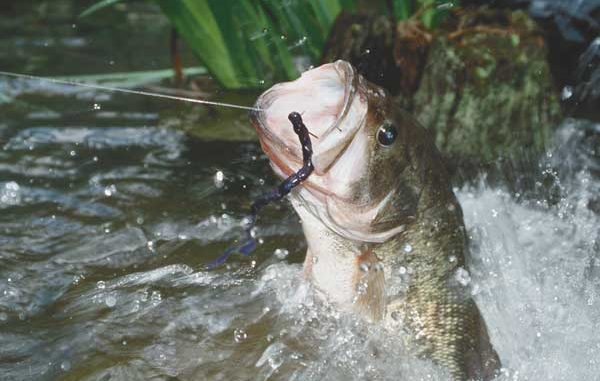
Discover the lures top largemouth anglers believe can turn an everyday fishing Joe into an aspiring bass pro.
Although the first plastic worms were made in the 1860s and the plastic worm was first patented in 1870, these early creations were lifeless and brittle and had little appeal to fish or anglers.With the discovery of flexible vinyls in the 1930s and the development of soft plastics in the 1940s and ’50s, plastic wigglers became viable, fish-catchers although still with shortcomings.
Early plastic worms employed a worm harness that originated from England. It had beads and small propeller blades for added attraction.
These threaded, plastic crawler rigs used multiple hooks, which were an improvement over the single hook or treble hook embedded in preceding worms. But rigged worms remained inflexible, with a tendency to snag everything they touched.
In the late ’40s, Nick Creme created the first soft, life-like plastic worm using colorfast, weatherproof and flexible materials based upon rubber and chemical products used at Akron, Ohio, factories.
After experimenting with soft-plastic formulas in his home kitchen for almost 12 months, Creme produced a lifelike worm, using night crawlers as models for his first molds. In 1949 Creme placed the first scented plastic worm on the market.
Other plastic worm pioneers, such as Bill Norton of Marion, Ind.; Dave Delong of Cleveland, Ohio; and Charles Burke of Traverse City, Mich., also experimented with plastics.
Ironically, these early plastic products didn’t catch on with anglers until they were banned from use.
During the 1050s, plastic worms were prohibited at pay-to-fish ponds in Georgia and elsewhere because they were so lethal for catching largemouth bass.
The word spread among bass fishermen, and suddenly the plastic worm found its way into almost every tackle box.
But problems persisted with the rigging apparatus of these worms.
Pre-rigged worms remained stiff and their exposed hooks couldn’t be fished through cover. Meanwhile “weedless” models weren’t that snagproof.
Jig heads, imbedded hooks and threaded single hooks either tore out of the worm or crimped their movements — and none of the rigs were weedless.
Always notorious tackle tinkerers, anglers sought more effective rigs for plastic worms, especially for fishing southern impoundments which resembled flooded forests with their standing timber and thick cover. Presenting a bait to bass holding at such snaggy places without hanging up seemed impossible.
Texas revolution
Then an ingenious angler fishing Lake Tyler in Texas during the late ’50s figured out a way to implant a single hook into a worm to make it virtually weedless.
The angler, whose name has been lost to history, inserted the point of a single hook into the nose of the worm, then pulled it out and gave it a slight twist before burying the point of the hook back into the worm near the worm collar. He also slid a cone-shaped weight on his line before the worm for casting weight.
The Texas rig was born.
The deadly weedless rig enabled fishermen to drag slithering plastics through the heaviest of cover and catch fish once thought reachable and uncatchable.
The Texas rig skyrocketed in popularity, not only because it caught fish but also because its development coincided with the emergence of Ray Scott’s BASS tournament trail in the 1960s.
BASS pros Bill Dance, John Powell, and Larry Nixon won so many tournaments with Texas-rigged plastic worms that any fisherman worth his patches learned how to rig a worm Texas style.
The Texas-rig craze led to innovations in fishing tackle. Offset worm hooks, sturdy worm rods, slick worm weights, softer plastic worms, and fluorescent lines were offshoots of the Texas-rig phenomenon.
Carolina craze
But another unknown fisherman had a different idea for rigging a plastic worm.
He slid a colored bead and a heavy egg sinker on the main line and tied the main line to one end of a barrel swivel. To the other end of the barrel swivel, he tied an 18- to 24-inch leader and to the business end of the leader, he tied a worm hook and embedded the hook into the plastic worm.
Although the origin of the Carolina rig is debated with both of the Carolinas claiming it as their own, many fishermen believe the rig was first used extensively at Santee-Cooper, S.C.
“The origin of the Carolina-rigged worm is less apparent,” said Ray Sasser in The Daily Morning News of May 23, 2004. “In fact, nobody seems to know which Carolina deserves credit.”
Unlike the Texas rig, the Carolina rig lingered in obscurity for years. Only a handful of fishermen used the rig until Alabama’s Jack Chancellor won the 1985 Bassmasters Classic at the Arkansas River using a Do-Nothing worm, the forerunner of the French fry worm, rigged Carolina style.
The subsequent publicity about the rig opened the eyes of bass anglers to its potential for probing structure along lake bottoms for sluggish bass.
Although Vlad Evanoff’s booklet “How to rig Plastic Worms” illustrates more than 30 ways to rig plastic worms, the Texas rig and the Carolina rig dominate the rigging wars in respect to the most effective way to rig soft plastics.
Even though improvements have been made with both rigs over the years, such as incorporating rattling devices into weights, developing lazer sharp worm hooks, downsizing components, and spicing up both presentations with garlic- and salt-laden worms of all sizes, shapes, and colors, the two rigs remain the same in principle to this day.
Although both rigs gained their notoriety through their use on the BASS tournament trail, the nature of tournament fishing has brought about a debate about which style catches more fish.
Choice of the pros
At present, the Carolina rig has emerged as the “go-to” rig among professional anglers.
St. Augustine, Fla., pro Peter Thliveros, who has amassed over $1,604,189 in BASS career winnings, including six victories, 38 top-10 finishes, and 76 top-20 finishes, owes much of his success to his extensive use of the Carolina rig.
“The use of the Texas rig has become somewhat of a lost art among touring pros,” Thliveros said. “Its presentation is too slow for many pros who want to ‘hit and go’ and fish for active fish.”
The distinct function of each rig explains why the Carolina rig has gained a stronger following. The Carolina rig is a search bait while the Texas rig is used for targeting fish buried in cover.
Carolina ‘search’ baits
As a search bait, the Carolina rig enables fishermen to learn the structural secrets of a lake bottom in a matter of hours instead of months. Reading the lake bottom was once a time-consuming task that required the use of a topographical map and endless casts with a deep-diving crankbait to discover cover and structure.
As Lexington crankbait artist David Wright bluntly said, the Carolina rig turned everyday fishing Joes into aspiring fishing pros.
“The Carolina rig made a lot of deep-water experts out of inexperienced fishermen,” Wright said. “What it took me years to learn about a lake bottom by bumping it with a crankbait took only several hours with a Carolina rig.”
Thliveros also attests to the Carolina rig’s efficiency.
“The Carolina rig is a great search bait, not just for fish, but also for telling everything that’s on a lake bottom,” he said. “I know everything that’s between me and my cast including the type of bottom, where it slopes, whether it’s mud, gravel, rock, or sand, and any cover along the way.”
Before the Carolina rig, some anglers used the Texas rig as a search bait but found it too slow and tedious for that purpose. The Texas rig wasn’t devised to cover a lot of ground or to be tossed long distances.
On the other hand, a Carolina rig commands the use of ¾- or 1-ounce weights, and the rig can be lobbed rather than cast, so it can be tossed a great distance without much effort.
The Carolina rig also was created as an open-water rig, whereas the Texas rig was designed for fishing heavy and often visible cover with fishermen employing short, pinpoint casts. This distinction explains why one rig is used more often than the other.
Anglers who are unfamiliar with a lake, which is the situation with most people once they leave their home waters, favor the Carolina rig. Fishermen with an intimate knowledge of a lake and its cover are best served by a Texas rig.
To illustrate, Thiveros said he uses the Texas rig for fishing tree laps, grass, lily pads and thick cover because they’re specific, visible targets.
“I’ll fish a Carolina rig before I’ll fish a Texas rig,” he said. “But if the fish are in a specific piece of cover, the Texas rig is perfect because the presentation can be made to that specific piece of cover.”
Texas rigs for targets
Wright prefers the Texas rig because he won’t fish a plastic bait until he has detected a specific target with a crankbait.
“I still use a crankbait as a search bait,” he said. “If I hit a stump or brush pile, and the crankbait stops producing, I’ll fish a worm Texas style.”
Wright uses a ½- to ¾-ounce weight with a Gamakatsu 5/0 wide gap worm hook for his Texas rig.
“With a Carolina rig, a lot of times fishermen are just probing the bottom, trying to hit some cover,” he said.
“But I’m throwing at a specific target, and the Texas rig forces me to be more accurate, to work the bait more slowly, and to concentrate more. With the Texas rig, I have to rely on my boat positioning and the use of my electronics to hit my targets.”
Yadkin Lakes guide Maynard Edwards prefers the Carolina rig — except when fishing heavy cover.
“Cover and the Carolina rig don’t get along,’ he said. “When the bass are tight to cover, the Texas rig is better.”
Whenever Edwards guides inexperienced clients, he resorts to the Carolina rig.
“The Carolina rig is ‘idiot proof’ and great for weekend warriors because they can just wind it in, and most of the time, the fish hooks itself,” Edwards said. “For novices it’s hard to detect a strike with the Texas rig and to know when to set the hook.”
New C-rig techniques
The Carolina rig is also more suitable to experimentation, and fishermen have made numerous modifications to the basic rig.
Chancellor’s “Do-Nothing” worm and its tiny hooks rigged Carolina style eventually gave way to softer plastics and finesse presentations.
The formation of softer stick baits, such as the French fry worm and centipede, enabled fishermen to use a stronger, single-worm hook with which they could bring in bigger bass with less risk than with the tiny hooks of the Do-Nothing worm.
Plastic stick baits, perhaps undeservedly, got the reputation of being “little fish baits,” so fishermen switched to other plastics, such as the plastic lizard, which soon became the standard bait found at the business end of most Carolina rigs.
The Carolina-rigged lizard proved so effective and became so widely used some anglers said largemouths became conditioned to plastic lizards and wouldn’t strike them as readily.
Consequently, today’s fisherman uses plastics of all shapes and sizes with the Carolina-rig in hopes of showing bass lures they haven’t seen before.
“I’ll use anything but the standard 6-inch plastic lizard or worm,” said Edwards, who thinks it’s important to fish something different.
“I go to either extreme and fish 4-inch finesse and French fry worms or 10 ½-inch Zoom Old Monster worms with a Carolina rig.”
Thliveros takes a more radical approach. He not only modifies the components of the rig but fishes the rig ever so slowly.
He uses a Zoom Super Fluke at the end of his rig and downsizes the rig with smart pegs used in conjunction with split-shot weights instead of heavy egg or bar sinkers and retrieves the bait without imparting much action to it.
“My technique is to fish slower than everyone else and to keep the bait in front of the fish as long as possible,” said the creator of the “Petey” rig. “This approach works best in heavily fished waters or with cold-water conditions when the fish are sluggish.”
E-v-e-n-t-u-a-l-l-y, Thliveros moves his rig, creeping it along the lake bottom at less than a snail’s pace. In between catnaps and yawns, he completes the retrieve and casts again and repeats the process.
Thliveros said the technique works in waters from New York to Florida — as long as the water is clear. The less active the fish and the tougher the bite, the more effective the “Petey” rig becomes.
For Carolina rigs, he uses a 7-foot, 2-inch medium-heavy American Rodsmith rod, an Ambassadeur Garcia reel with a 6:3:1 ratio to take up slack quickly for better hooksets, and 8- to 12-pound test fluorocarbon line, which has more sensitivity but less stretch than monofilament line.
Thliveros also said the sinker of the Carolina rig acts as a “dinner bell” to bass because they respond to its noise. For that reason, he chooses 1/8- to 1-ounce tungsten weights for their greater sensitivity and unique sound.
“Tungsten weights sink faster and translate feel up the line better, so an angler can detect the composition of the lake bottom easier,” he said.
Thliveros also adjusts the length of his leader, depending upon conditions. With a strong wind, he shortens his leader to 18 to 20 inches. For search purposes, he lengthens his leader.
Thliveros said many anglers have the misconception that Carolina-rigged plastics suspend above the lake bottom.
“Salt sinks, so most plastics don’t float the hook but stay on the lake bottom behind the sinker,” he said. “It’s the motion of the sinker that makes the plastics rise and fall.
“The plastic lizard became popular because it falls slower behind the sinker than most plastic worms.”
Another misconception about the Carolina rig is that it’s mainly a summertime deep-water rig.
Yadkinville’s Danny Haire said he fishes a Carolina rig 95 percent of the time and year-round.
During the spawning period, he targets pre- or post-spawn fish with the Carolina rig, contending not all bass spawn at once. At a spacious lake, he said fish spawn at different times, so during winter he slows the rig to a crawl.
The toughest period for the Carolina rig, he said, is the fall when the fish are roaming after forage, but he still catches bass suspended above brush with the Carolina rig. The other obstacle is strong wind that moves his boat constantly.
Haire also adjusts his leaders. For suspended fish and clear water, he uses a 4- to 5-foot 10-pound-test leader; for stained water and stump fishing, he uses a 2- to 3-foot 12-to 14-pound-test leader.
Plastic worms and worm rigs have come a long way since the tough inflexible offerings of yesteryear. The obvious winners of America’s bass rigging wars have been anglers.
With the creation of the Texas rig and Carolina rig, they have two of the most effective rigging options ever devised for catching bass with plastics under diverse conditions.

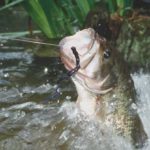
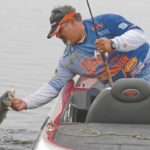
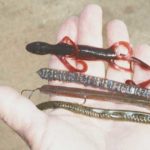
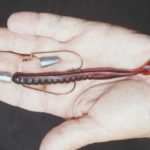
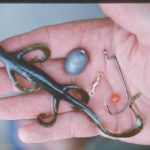
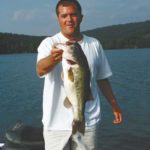


1 Trackback / Pingback